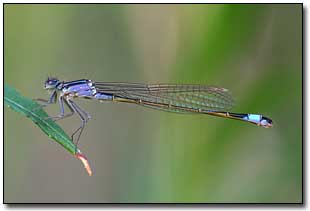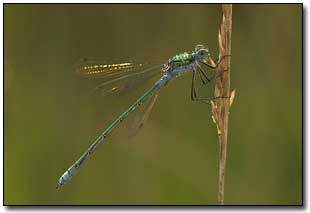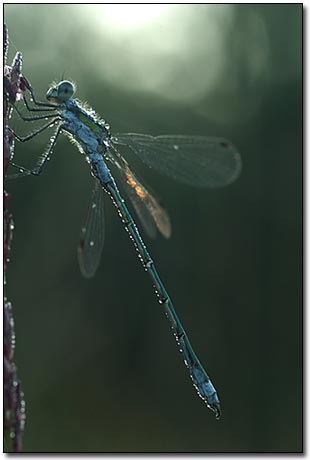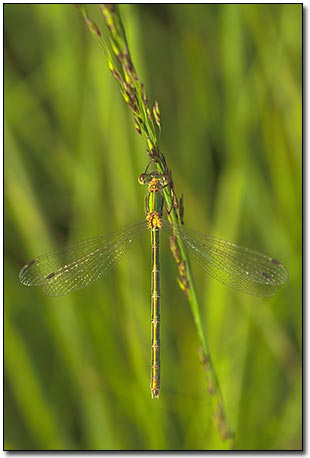|
My interest in damselfly photography was actually kindled some time during the
summer of 2003 while I was attempting to photograph the Red Deer of Jutland in
Denmark.
 One early June morning I am sitting, looking for Red Deer by a small lake in mid
Jutland where I know the deer regularly come. It is just after sunrise but I have
already been sitting there for a couple of hours, waiting without any result, just
like the evening before. I am close to concluding that there will not be any
pictures of Red Deer this time and that is actually also quite okay with me. After
sitting for a total of 10 hours on a somewhat uncomfortable folding chair in what
was first baking heat the day before and then in cold and clammy morning fog this
morning where the highlights have been a Raven passing far overhead and a few Wood
Pigeons coming down to the lake for water I am actually starting to get a bit bored.
While the first sunrays clear the spruce trees that surrounds the pond, myriads of
damselflies emerges everywhere while they are waiting for the sun to warm them
sufficiently to be able to fly. The tiny insects are covered in dew drops and in the
orange glow of the morning light they resemble tiny glittering jewels as they cling
to each their own straw. Quickly I changed tactics; the tele lens (on which the
front element was covered in dew anyway) was replaced by a macro lens by which I was
hoping to turn the events in front of me into photographic master pieces. It didn't
take long however before I had to realize that the dense dew was both good and bad:
good as the light became perfect as it pierced through the morning fog and because
the moisture condensed into the finest little dew drops on plants and insects but
bad because it also condensed into the finest little dew drops on the photographic
equipment and because boots and trousers were quickly soaked. While I was jumping
from tussock to tussock trying desperately to photograph what I was seeing before
the insects were heated up I miraculously managed to get a number of images that
were quite okay. Actually the images were so good I decided to put some more effort
into damselfly photography after seeing the results from that morning.
One early June morning I am sitting, looking for Red Deer by a small lake in mid
Jutland where I know the deer regularly come. It is just after sunrise but I have
already been sitting there for a couple of hours, waiting without any result, just
like the evening before. I am close to concluding that there will not be any
pictures of Red Deer this time and that is actually also quite okay with me. After
sitting for a total of 10 hours on a somewhat uncomfortable folding chair in what
was first baking heat the day before and then in cold and clammy morning fog this
morning where the highlights have been a Raven passing far overhead and a few Wood
Pigeons coming down to the lake for water I am actually starting to get a bit bored.
While the first sunrays clear the spruce trees that surrounds the pond, myriads of
damselflies emerges everywhere while they are waiting for the sun to warm them
sufficiently to be able to fly. The tiny insects are covered in dew drops and in the
orange glow of the morning light they resemble tiny glittering jewels as they cling
to each their own straw. Quickly I changed tactics; the tele lens (on which the
front element was covered in dew anyway) was replaced by a macro lens by which I was
hoping to turn the events in front of me into photographic master pieces. It didn't
take long however before I had to realize that the dense dew was both good and bad:
good as the light became perfect as it pierced through the morning fog and because
the moisture condensed into the finest little dew drops on plants and insects but
bad because it also condensed into the finest little dew drops on the photographic
equipment and because boots and trousers were quickly soaked. While I was jumping
from tussock to tussock trying desperately to photograph what I was seeing before
the insects were heated up I miraculously managed to get a number of images that
were quite okay. Actually the images were so good I decided to put some more effort
into damselfly photography after seeing the results from that morning.
This article will concentrate on photography on fully developed damselflies although
the often ignored area of larvae photography holds interesting possibilities, as
 with any area of nature photography only your imagination defines the limits.
Damselfly photography is obviously much like any kind of insect photography although
one needs to keep a few details in mind when attempting this specific branch of
macro photography. As an example the fact that the small size of the damselflies
demands dedicated macro equipment like macro lenses, extension tubes, teleconverters
or close-up lenses in order to be able to depict any kind of detail on the insects.
Personally I prefer my trusty old 90 mm Tamron macro lens as it is a perfect
compromise between reach and the ability to photograph hand-held in natural lighting, at least for me.
with any area of nature photography only your imagination defines the limits.
Damselfly photography is obviously much like any kind of insect photography although
one needs to keep a few details in mind when attempting this specific branch of
macro photography. As an example the fact that the small size of the damselflies
demands dedicated macro equipment like macro lenses, extension tubes, teleconverters
or close-up lenses in order to be able to depict any kind of detail on the insects.
Personally I prefer my trusty old 90 mm Tamron macro lens as it is a perfect
compromise between reach and the ability to photograph hand-held in natural lighting, at least for me.
Extra care is required in order to keep the damselfly parallel to the film plane as
the long body of the insect will otherwise result in an image where the front is in
focus but the rear is not or the other way around. One could of cause want to do
this on purpose as an effect but it will be obvious to anyone if this is done
consciously or it is just a result of poor technique. Most species keep their wings
parallel to their body when resting which makes use of a relatively low depth of
field possible compared to photography of beetles for example. This makes it a lot
easier to obtain a nice and 'creamy' and even-coloured background than by
photography of more 'round' insects.
Be careful not to let vibrations due to wind ruin the shot, an average sized
damselfly weighs just fifty milligram, one twentieth of a gram. Obviously any
amount of wind will make photography challenging.
The damselflies are much more cooperative early morning and late afternoon when
 their body temperature is low than when the air is warm allowing the insects to fly
around but when they are sitting in the vegetation they can be very difficult to
find. I have used a simple technique myself which simply is to sit down on the same
spot for 10-20 minutes at sunrise and watch the vegetation. This way you will
gradually spot the insects as they emerge from the dense low vegetation and crawl up
on grass and branches to let them selves be warmed by the sunlight. If you just
thunder head-first through the vegetation chances are you will not see the insects
and even if you manage to find some they will probably attempt to hide away and be
difficult to photograph. Even if the insects are slow when they are cold they will
still be spooked if you approach too fast with the photographic equipment and if
that happens they will attempt to hide somewhere they cannot be easily seen or as a
last desperate attempt let themselves fall to the ground.
their body temperature is low than when the air is warm allowing the insects to fly
around but when they are sitting in the vegetation they can be very difficult to
find. I have used a simple technique myself which simply is to sit down on the same
spot for 10-20 minutes at sunrise and watch the vegetation. This way you will
gradually spot the insects as they emerge from the dense low vegetation and crawl up
on grass and branches to let them selves be warmed by the sunlight. If you just
thunder head-first through the vegetation chances are you will not see the insects
and even if you manage to find some they will probably attempt to hide away and be
difficult to photograph. Even if the insects are slow when they are cold they will
still be spooked if you approach too fast with the photographic equipment and if
that happens they will attempt to hide somewhere they cannot be easily seen or as a
last desperate attempt let themselves fall to the ground.
Not all species of damselflies are easy photographic targets; some species prefer to
stay in the swamp resting on Bulrush and Reedmace or on the floating leaves of
water-lilies and when photographing these species a small boat will come in handy
although in most situations a pair of rubber boots and a good dose of patience will
suffice.
Photography using a tripod is difficult as the insects will most often fly off if
one accidentally bumps the tripod against the vegetation when setting it up. Mid-day
 the insects are usually too active to wait for the tripod to be set up anyway. A
useful compromise could be a monopod which is much easier and quicker to set up but
which at the same time is quite useful to help steady the camera. I rarely use
artificial lighting myself but flash photography absolutely has its merits.
Especially on days where the light is not strong enough to attain the desired depth
of field and shutter speed or when the light is too bright resulting in solid black
shadows without a flash to loosen up the shadows it is difficult to do without
artificial lighting. As always one has to be aware that the use of flash can result
in a totally black background if the distance between the flash and the damselfly is
much smaller than the distance between the flash and the background. It is up to one
self whether to see this as 'dramatic' or 'phoney-looking'.
the insects are usually too active to wait for the tripod to be set up anyway. A
useful compromise could be a monopod which is much easier and quicker to set up but
which at the same time is quite useful to help steady the camera. I rarely use
artificial lighting myself but flash photography absolutely has its merits.
Especially on days where the light is not strong enough to attain the desired depth
of field and shutter speed or when the light is too bright resulting in solid black
shadows without a flash to loosen up the shadows it is difficult to do without
artificial lighting. As always one has to be aware that the use of flash can result
in a totally black background if the distance between the flash and the damselfly is
much smaller than the distance between the flash and the background. It is up to one
self whether to see this as 'dramatic' or 'phoney-looking'.
If one belongs to the group of photographers who prefer to be able to put a species
name on a particular damselfly then they will have a challenge as many species look
alike on first glance. That is the reason that a deep knowledge is required to be
able to know which distinguishing features should be clearly visible on the photos
if they should have both an artistic as well as a documentary value. The backside of
the head, the 'chest' (thorax and prothorax) as well as the first and last parts of
the abdomen will in most instances provide the key information needed in determining
the species.
I myself have spend quite a few interesting hours by lakes and rivers while
searching for damselflies to photograph after my first 'damselfly experience' in
2003 and would heartily encourage anyone to grab the camera and the rubber boots and
get out there.
...The damselflies are waiting out there!
| 
